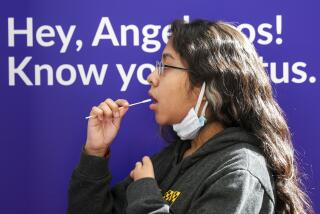Exercise can be contagious, new social network analysis finds

- Share via
Now here’s a contagion that might not be so bad to encounter. A new analysis of the running habits of about 1.1 million people reveals that exercise is indeed contagious — though its communicability depends on who’s spreading it.
The findings, published in the journal Nature Communications, also reveal that certain relationships are better at spreading the running bug than others — and could have implications for the study of other social contagions, such as obesity and smoking.
In recent years, researchers in a wide range of fields — from economics and politics to medicine and computer science — have begun to investigate the ways in which many of our individual decisions affect the decisions of our peers, and how behavioral changes may spread through a social network.
“If behavioural contagions exist,” the study authors wrote, “understanding how, when and to what extent they manifest in different behaviours will enable us to transition from independent intervention strategies to more effective interdependent interventions that incorporate individuals’ social contexts into their treatments.”
Creating health and other interventions that effectively could harness the social network to maximize their benefit would be a real game-changer, researchers say. But it’s been difficult to draw conclusions from studies based on self-reporting surveys (where participants may not be fully honest or aware of their own behaviors) or laboratory experiments (which may not fully capture the real-life complexities of causal relationships within social networks).
So for this paper, Sinan Aral and Christos Nicolaides of the Massachusetts Institute of Technology used fitness tracker data to study the running and activity habits of around 1.1 million people in an actual global social network. The runners had formed about 3.4 million social network ties; the researchers analyzed the 2.1 million or so ties for which they could pinpoint geographic location and weather information for both users. Over five years, these social media users ran a collective 350 million kilometers — and their runs were all automatically posted online for their friends to see, reducing the issues that come with self-reporting.
On the same day on average, an additional kilometer run by friends influences an individual to run an additional 0.3 kilometers. An additional kilometer per minute run by friends pushes a person to run an additional 0.3 kilometers per minute faster than usual. If those friends run an extra 10 minutes, that person is likely to run about three minutes longer than they would have. If those friends burn an extra 10 calories, that person will end up burning 3.5 more calories.
The effect is strongest on the same day and appears to diminish with time, the authors wrote.
So the scientists found that a runner’s peers did influence him or her to run more — but they also discovered that not all users influenced their buddies equally. Individuals were more likely to be prodded to up their game by less-active peers than by more active ones. Men were influenced by the activity of both men and women, but women were influenced only by other women. Inconsistent runners influenced consistent runners far more than the other way around.
“Social comparisons may provide an explanation for these results,” the study authors wrote. Social comparison theory, they added, “proposes that we self-evaluate by comparing ourselves to others.”
But do we make upward comparisons to peers performing better than us, or downward comparisons to those performing worse? That’s been a subject of debate, the researchers said.
“Comparisons to those ahead of us may motivate our own self-improvement, while comparisons to those behind us may create ‘competitive behaviour to protect one’s superiority,’ ” they explained. “Our findings are consistent with both arguments, but the effects are much larger for downward comparisons than for upward comparisons.”
So people who we think are our closest fitness “peers” — particularly those who we think are slightly lower on the totem pole relative to ourselves — are most likely to get us to push our limits.
There are possible explanations in the scientific literature for the gender divide too, the scientists added.
“For example, men report receiving and being more influenced by social support in their decision to adopt exercise behaviours, while women report being more motivated by self-regulation and individual planning,” the study authors wrote. “Moreover, men may be more competitive and specifically more competitive with each other. Experimental evidence suggests that women perform less well in mixed gender competition than men, even though they perform equally well in non-competitive or single sex competitive settings.”
The findings reveal how effective monitoring these real-time networks may be to help scientists design all kinds of interventions to minimize the spread of social ills and maximize the spread of social benefits.
“The granularity and precision with which fitness tracking devices record real-world health behaviours portends a sea change in our understanding of human behaviour and social influence at scale,” the study authors wrote. “Compared with prior studies, which relied on imprecise and frequently inaccurate self-reports, the potential for these kinds of data to extend our understanding of social behaviour in real-world settings is difficult to overstate.”
It also highlights the fact that looking at “average” social influence may not be the most helpful indicator, especially when — as this study showed — influence on any given branch of a social network is not necessarily a two-way street.
“Different subsegments of the population react differently to social influence,” the authors said. “Such differences suggest that policies tailored for different types of people in different subpopulations will be more effective than policies constructed with only average treatment effects in mind.”
Follow @aminawrite on Twitter for more science news and “like” Los Angeles Times Science & Health on Facebook.
MORE IN SCIENCE
Why doctors are being urged to join the March for Science on Saturday
What would make a computer biased? Learning a language spoken by humans
Type 2 diabetes, once considered a disease for adults, is increasingly common in tweens and teens







